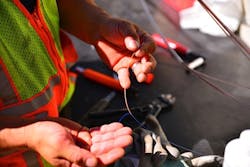AT&T has told the Federal Communications Commission (FCC) that the Commission (and just about everyone else) misinterpreted comments from AT&T President and CEO Randall Stephenson regarding the service provider's unwillingness to roll out high-speed broadband services due to Net Neutrality concerns. Stephenson wasn't talking about the 2 million homes AT&T promised to connect if its acquisition of DirecTV is approved (see "AT&T to buy DIRECTV for $48.5 billion"). Nor was he talking about the 25 markets where AT&T has announced its intention to expand (see "AT&T releases list of potential new 1-Gbps FTTH markets"). It's anything else the company might have been considering that Stephenson was referring to, AT&T now informs the FCC.
The clarification came in a letter to the FCC written November 25 in response to an FCC request for additional information on its current and future plans (see "FCC wants AT&T GigaPower FTTH details"). Stephenson commented at a Well Fargo investment conference November 12 that President Barack Obama's call for the FCC to reclassify Internet service provision under Title II of the 1996 Telecom Act had led him to hold off on 1-Gbps U-verse with GigaPower roll outs until the Net Neutrality issue is settled. A lawyer aiding the FCC's review of the DirectTV acquisition demanded an explanation of Stephenson’s comments and AT&T's subsequent broadband plans. The lawyer assumed, as did the media and other observers, that Stephenson had halted AT&T’s ongoing GigaPower deployments, except those directly attached to the DirecTV acquisition.
The FCC request called for AT&T to detail where it planned to provide high-speed broadband access services via fiber to the node (FTTN) and fiber to the home (FTTH). The FCC also wanted to know if AT&T viewed broadband deployment as an unprofitable activity.
The FCC released a copy of the seven-page response late last week – or at least a copy of it supplied by AT&T with information the company considered proprietary redacted. The redacted info includes a four-page list of the "designated market areas" where AT&T serves customers via either FTTN or FTTP and the areas where additional FTTN deployments are planned.
"The premise of the Commission's November 14 Letter is incorrect. AT&T is not limiting our FTTP deployment to 2 million homes," reads the letter, signed by Robert W. Quinn, Jr., AT&T's senior vice president-federal regulatory and chief privacy officer. "To the contrary, AT&T still plans to complete the major initiative we announced in April to expand our ultra-fast GigaPower fiber network in 25 major metropolitan areas nationwide, including 21 new major metropolitan areas. In addition, as AT&T has described to the Commission in this proceeding, the synergies created by our DirecTV transaction will allow us to extend our GigaPower service to at least 2 million additional customer locations, beyond those announced in April, within four years after close."
However, anything after those deployments is up in the air, Quinn wrote. "To be clear, AT&T has not stated that the President's proposal would render all of these locations unprofitable. Rather, AT&T simply cannot evaluate additional investment beyond its existing commitments until the regulatory treatment of broadband service is clarified," he added.
Determining which markets might be in limbo can’t be determined without the redacted information. The letter also did not detail how much clarity AT&T seeks. The FCC has not publicly commented on the AT&T response as of this writing.
For more information on FTTx equipment and suppliers, visit the Lightwave Buyer's Guide.

Stephen Hardy | Editorial Director and Associate Publisher
Stephen Hardy has covered fiber optics for more than 15 years, and communications and technology for more than 30 years. He is responsible for establishing and executing Lightwave's editorial strategy across its digital magazine, website, newsletters, research and other information products. He has won multiple awards for his writing.
Contact Stephen to discuss:
- Contributing editorial material to the Web site or digital magazine
- The direction of a digital magazine issue, staff-written article, or event
- Lightwave editorial attendance at industry events
- Arranging a visit to Lightwave's offices
- Coverage of announcements
- General questions of an editorial nature
